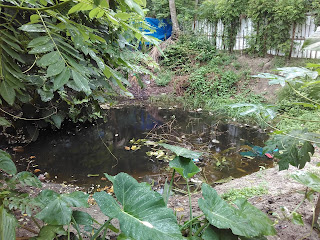This is a continuation from the previous post -
http://biometrust.blogspot.com/2017/06/visit-to-kaikondrahalli-lake-for.html.
Instead of eating lunch, we go on to the next agenda item - to check the water level sensors. We noticed one part of the lake path cordoned off for construction activity.
--------------------------------------------------------
 |
| Odyssey water level sensor |
This is the Odyssey water level sensor that has been installed. The counterweight makes sure that the sensor wire is held taut or straight so that water levels are logged accurately. The other end is the logger which logs the readings.
The sensing element is actually the teflon coated wire which is immersed in the water. So the wire inside forms one plate of a capacitor, the teflon acts as the dielectric and the surrounding water forms the other plate of the capacitor. The varying water level causes corresponding changes to the capacitance, which is detected and correlated to the actual water level through a process of calibration.
--------------------------------------------------------
The water level sensor was also installed at the same time as the DO sensor (Feb 16). It was installed in the 2 sewage inlets of the lake. This is one of the inlets.
The data logger is inside the metal box at the top, the counterweight is resting on the sewage inlet floor and the Teflon-coated sensing element (the wire) is going up from the counterweight through the PVC pipe to the data logger. The frequency of sensing (how often the reading is taken) is set to 15 mins for this sensor.
--------------------------------------------------------
The logger is kept inside the metal housing, enclosed in a plastic bag to protect it from rain.
--------------------------------------------------------
The sewage water velocity is measured at different times by using a velocity meter - a different instrument. It can also be measured by a manual method.
By multiplying the depth of the sewage water by the width of the channel and the velocity of sewage water flow, one can arrive at volume flowing per unit of time or in other words the flow rate of sewage. This multiplied by time (say a day) can give the amount of sewage that is flowing into the lake in a day.
Shown in the above picture is a graphic illustration of the same with some example values.
--------------------------------------------------------
The data logger is connected to the laptop to download the readings for the last 3 weeks
--------------------------------------------------------
 |
| Scrutinising the readings to see if they look ok. |
--------------------------------------------------------
The path to the next sewage inlet was blocked (intentionally) by a thicket of uprooted branches. We had to pry our way in through one side. Sid keeps the mobile lab box in the middle, to be picked up after we reach the other side.
--------------------------------------------------------
Stepping over the branches on the side to make our way and then climb up over the ditch to get on to the path.
--------------------------------------------------------
We reach the second sewage inlet where another Odyssey water level sensor is installed.
--------------------------------------------------------
 |
| Taking a look at the downloaded data readings from this sensor |
--------------------------------------------------------
Starting the process of doing a field calibration of the sensor. The earlier one had been calibrated right after installation.
For calibration, readings are taken at 2 known heights (minimum and maximum) of immersion into the sewage. The actual sensor readings are compared with the known min and max values by the software and the differences are recorded. And the needed adjustment is automatically applied to subsequent data readings from the sensor.
--------------------------------------------------------
For marking the max point on the wire sensing element we find a plastic straw lying nearby and tie it around the wire.
And soon after (for which I have no picture trail) there was a mishap. Sid accidentally dropped the logger end into the sewage and despite scrambling quickly to retrieve it and cleaning it up, it appeared to have got messed up based on the readings that were observed after the fall.
So Sayan decided to take back the instrument with him to ATREE to check if it was just a temporary issue due to the liquid entering the instrument or whether it had got damaged permanently.
--------------------------------------------------------
After an exhausting day, we went to nearby Nandini's for lunch - at around 4 pm. Sayan and Sid catching up with the world.
#ORCLCitizenship #tripszee #OracleGiving #atree_org








































